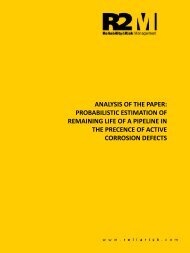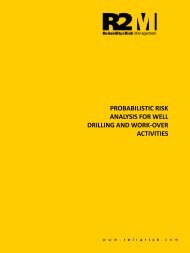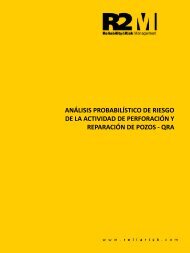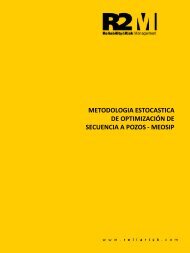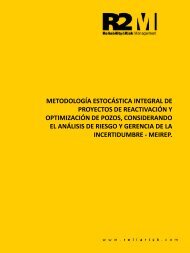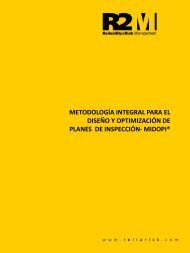Stochastic Evaluation of Exploration Assets - MEIVAE
Create successful ePaper yourself
Turn your PDF publications into a flip-book with our unique Google optimized e-Paper software.
Medardo Yañez, Karina Semeco, Michele Leccese, Pedro Gil, José Fariñas, Miguel Agüero. 4<br />
Figure 2 - Diagram <strong>of</strong> the Procedure for Probabilistic<br />
Characterization <strong>of</strong> the Averages Values <strong>of</strong> the Properties<br />
(porosity, saturation, thickness), from Insufficient Evidence and<br />
Analog Data, with Bayes' Theorem”<br />
<br />
<br />
Properly treat probabilistic dependence between "multiple"<br />
geological targets or "layers" within the same prospect.<br />
References [11], [13], [14] are excellent papers that address<br />
the issue mentioned in detail.<br />
In case <strong>of</strong> requiring the sum <strong>of</strong> resources, it is important to<br />
consider the dependence between prospects and the level <strong>of</strong><br />
uncertainty <strong>of</strong> each estimate, the item is treated in detail in<br />
Chapter 6 <strong>of</strong> reference [16], and is considered a key aspect to<br />
calculate resources.<br />
Stage 2.2: Estimating the Probability <strong>of</strong> Geological Success or<br />
Probability <strong>of</strong> Discovering (Pg) for each prospect that integrates<br />
the <strong>Exploration</strong> Portfolio, considering interdependence between<br />
prospects and geological targets.<br />
To estimate the Probability <strong>of</strong> Geological Success (Pg), it is<br />
established the ranges <strong>of</strong> probability <strong>of</strong> existence <strong>of</strong> each <strong>of</strong> the<br />
processes that are required for the oil system to operate:<br />
<br />
<br />
<br />
<br />
Presence <strong>of</strong> a reservoir or reservoir rock.<br />
Presence <strong>of</strong> a Trap<br />
Presence <strong>of</strong> a Hydrocarbon Charge System<br />
Effective retention <strong>of</strong> oil after migration.<br />
Consequently, the model to estimate the Probability <strong>of</strong> Detection<br />
(Pg) is based on four probabilistic parameters:<br />
<br />
<br />
<br />
<br />
P1: Probability <strong>of</strong> the presence <strong>of</strong> an effective reservoir or<br />
reservoir rock.<br />
P2: Probability <strong>of</strong> the presence <strong>of</strong> an effective Trap.<br />
P3: Probability <strong>of</strong> the presence <strong>of</strong> a Hydrocarbon Loading<br />
System.<br />
P4: Probability <strong>of</strong> an effective retention <strong>of</strong> oil after migration.<br />
Finally, the Probability <strong>of</strong> Discovering (Pg), is estimated with the<br />
following model:<br />
Pg= P1 x P2 x P3 x P4 (1)<br />
Pg= P(Reservoir Rock) x P(Trap) x P(Charge) x P(Retention)<br />
NOTE: The following explains with more detail each <strong>of</strong> these<br />
probabilistic parameters:<br />
<br />
Muestra de<br />
tamaño “m”<br />
H1<br />
H2<br />
H3<br />
H4<br />
H5<br />
.<br />
.<br />
.<br />
.<br />
.<br />
.<br />
Hm<br />
Muestra de<br />
tamaño “n”<br />
h1<br />
h2<br />
h3<br />
.<br />
.<br />
.<br />
.<br />
hn<br />
Prior Knowledge –<br />
Datos Análogos<br />
m<br />
<br />
Hi <br />
i 1 sH<br />
<br />
H<br />
<br />
<br />
.<br />
m<br />
1 <br />
.<br />
m 1<br />
<br />
m<br />
2 <br />
H<br />
i H .<br />
<br />
i 1<br />
H<br />
SH<br />
<br />
g <br />
NormalH , <br />
m <br />
<br />
<br />
<br />
<br />
<br />
S<br />
L<br />
<br />
h<br />
<br />
H<br />
Normal h ,<br />
n <br />
h<br />
n<br />
<br />
hi <br />
i 1<br />
h<br />
<br />
<br />
.<br />
sh<br />
<br />
n<br />
S <br />
H<br />
<br />
m <br />
S <br />
h<br />
<br />
n <br />
1 <br />
.<br />
n 1<br />
<br />
Evidence –<br />
Datos Propios<br />
n<br />
2 <br />
h<br />
i h .<br />
<br />
i 1<br />
m <br />
2<br />
s<br />
<br />
H<br />
H<br />
POSTERIOR <br />
H .....<br />
n m<br />
<br />
2 2<br />
s<br />
s<br />
<br />
h<br />
H <br />
n <br />
2<br />
sh<br />
<br />
.................. <br />
h<br />
n m<br />
<br />
2 2<br />
s<br />
h<br />
sH<br />
<br />
<br />
<br />
POSTERIOR<br />
<br />
<br />
<br />
<br />
1<br />
<br />
<br />
<br />
<br />
n m<br />
2<br />
2 <br />
s<br />
h<br />
s<br />
H<br />
<br />
P1: Probability <strong>of</strong> the presence <strong>of</strong> an effective reservoir<br />
or reservoir rock.<br />
H<br />
Teorema de Bayes<br />
L<br />
H<br />
<br />
<br />
<br />
<br />
<br />
<br />
g <br />
f<br />
<br />
<br />
H <br />
L<br />
H<br />
<br />
<br />
<br />
<br />
g d<br />
<br />
<br />
<br />
Posterior Knowledge –<br />
Información Mejorada<br />
H POSTERIOR<br />
H POSTERIOR<br />
This probability includes two aspects:<br />
The first aspect (P1a): is the probability <strong>of</strong> existence <strong>of</strong> the facies<br />
in the reservoir with the minimal properties such as net / gross and<br />
thickness.<br />
The second aspect (P1b): is the probability that the reservoir rock<br />
has effective properties <strong>of</strong> porosity, permeability and hydrocarbon<br />
saturation.<br />
Finally: P1= P1a x P1b (2)<br />
P2: Probability <strong>of</strong> the presence <strong>of</strong> an effective Trap:<br />
This probability includes two aspects:<br />
The first aspect (P2a): is the probability <strong>of</strong> existence <strong>of</strong> a reservoir<br />
rock volume<br />
The second aspect (P2b): is the probability that there is an<br />
effective seal mechanism for the structure and the trap had<br />
formed.<br />
Finally: P2= P2a x P2b (3)<br />
P3: Probability <strong>of</strong> the presence <strong>of</strong> a Hydrocarbon Charging<br />
System.<br />
This probability includes two aspects:<br />
The first aspect (P3a): is the probability <strong>of</strong> existence <strong>of</strong> a source or<br />
generating rock<br />
The second aspect (P3b): is the probability <strong>of</strong> efficient<br />
migration from the source rock to the trap.<br />
Finally: P3= P3a x P3b (4)<br />
P4: Probability <strong>of</strong> an effective retention <strong>of</strong> oil after migration:<br />
evaluates the probability that the trap has been filled with<br />
hydrocarbon in a given period in time.<br />
The "Guidelines for Risk Assessment <strong>of</strong> Petroleum Prospects" [15] ,<br />
addresses in detail the issue <strong>of</strong> estimating each <strong>of</strong> the parameters<br />
involved in the estimation <strong>of</strong> the (Pg).<br />
The estimate <strong>of</strong> (Pg) for each <strong>of</strong> the prospects that<br />
are part <strong>of</strong> an exploratory portfolio is a known and<br />
dominated aspect by exploratory organizations in the<br />
industry; however, one aspect that requires special<br />
attention in the estimation <strong>of</strong> the (Pg) is to consider<br />
the effect <strong>of</strong> dependency between prospects and<br />
dependence between different geological targets.<br />
NOTE: The probabilistic dependency or "interdependence<br />
between exploration opportunities or prospects" implies that the<br />
result <strong>of</strong> the drilling <strong>of</strong> any <strong>of</strong> the prospects (with success or<br />
failure), impacts the likelihood <strong>of</strong> discovery <strong>of</strong> the others.<br />
The independence between prospects can be assumed for<br />
example in the case that they belong to different geological plays,<br />
but if they belong to the same play, then they should be<br />
considered interdependent.<br />
Such probability calculations are based on conditional probabilities<br />
and are governed by the so-called Bayes Theorem [1], [2], [3], [4], [15] .<br />
To illustrate the effect <strong>of</strong> the interdependence, an example <strong>of</strong> 5<br />
prospects "X" located in an exploratory area and that are<br />
considered exploratory dependent is shown. As explained in the<br />
equations (1), (2), (3) and (4) to estimate the (Pg) is necessary to<br />
consider multiple probabilistic parameters.<br />
In the case <strong>of</strong> interdependent prospects, the factors <strong>of</strong> the above<br />
equation must be separated into two groups; common factors to all<br />
prospects, generating a probability P (S), and factors that are not<br />
common to the different prospects under analysis, generating<br />
different probabilities denoted as P (X / S). In this case, by







